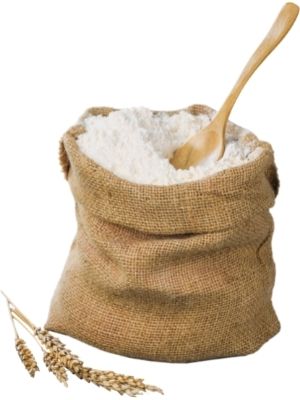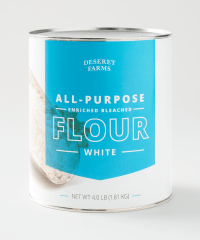Preparedness Challenge Week 10
This is Part 1 of a two-part blog post. This week the preparedness challenge is to add flour to your food storage. Next week we will look at whole grains. Both have a place in your food storage. I will try to point out the pros and cons of each, and ultimately you can decide whether flour or grains, or a combination of both, suit your your preparedness needs.
Flour Is a Basic Ingredient

Flour is an important basic storage item for every type of food storage plan. Grains were ground into flour and used to make breads in ancient cultures dating back over 10,000 years ago. Flour was one of the first processed foods and improved the diet of early people and helped hunters and gatherers transition to farming. Some form of bread making is found in every culture. You could say that bread making was a technology that helped make us human.
Sometimes bread gets a bad rap because of its high carb count and other health liabilities. But in a time of crisis, you’ll need those carbs, and bread will be welcome and comforting nourishment. Bread made from whole grains is especially nutritious.
Should I Store Flour or Whole Grains?
The answer is, “Both!” A good case can be made for having both flour and whole grains in your food storage! The main advantage to storing flour is that it is already processed and ready to use. It is also familiar and an ingredient in countless baked foods. However, flour does not have a long shelf life, and it costs one-fourth to one-third more than whole grains. On the other hand, whole grains have a very long shelf life if stored properly, but they must be milled or ground to be used as flour, and so require a grain mill.
Types of Wheat Flour
ENRICHED ALL-PURPOSE FLOUR
All-purpose flour (11%-12% protein) is a fundamental ingredient for baking. It is the most common type of flour and typically what we find in the baking aisle at the grocery store. All-purpose flour is made from the starchy endosperm of wheat kernels. It does not contain the bran—the fibrous outer coating—nor the nutrient-dense wheat germ.
All-purpose flour is usually made from a combination of hard and soft wheats with varying protein levels. It is enriched and so has nutrients added to it. But it contains less protein, fiber, vitamin E, essential fatty acids, and calcium than the whole wheat it came from.
This flour is often bleached to give it an appealing bright, white appearance. Bleaching also makes it softer and makes baked goods more tender. Unbleached flour has stronger gluten protein which is desirable for making bread.
BREAD FLOUR
Bread flour (12%-13% protein) is white flour made from wheat with a higher protein content than all-purpose flour. The protein, also called gluten, gives yeast bread its structure.
CAKE FLOUR
Cake flour (6%-8% protein), along with pastry flour (8%-9% protein), is made from wheat with a lower protein content. Both give baked goods like cakes and biscuits a soft texture but are not recommended for making bread.
WHOLE WHEAT FLOUR
Whole wheat flour is made from the entire wheat kernel. It contains the bran and germ along with the endosperm which makes it more nutritious than white flour.
Most whole wheat flour is milled from two common types of wheat—hard red wheat (14% protein) and hard white wheat (13% protein). Red wheat has a brownish-red color and a robust, nutty flavor. White wheat is light brown and has a mild flavor. Both have a high protein content which makes them suitable for making bread.
Breads made from whole wheat flour tend to be heavier and crumblier, but with good recipes, sound techniques, and practice, they need not be that way. It is worth the effort to learn to make your own whole wheat bread. Prepared properly, home-baked whole wheat bread will make factory-produced commercial breads lose their appeal forever.
Tips for Substituting Whole Wheat Flour for White Flour
Whole wheat flour is not as soft as all-purpose white flour, but it can often be substituted for it. In some baked goods the substitution is barely noticeable, but in others, the finished product may be denser and have a crumbly texture. Here are some tips to help make the substitution successful.
- Alter your expectations; don’t expect whole wheat flour to make the same product as white flour.
- Look for recipes that specifically call for whole wheat flour.
- Use whole wheat flour in baked goods that lend themselves to whole wheat flour such as cookies, muffins, biscuits, waffles, and pancakes.
- Use flour made from hard white wheat rather than hard red wheat for a product that is closer to those made with regular white flour.
- Use freshly ground flour because whole wheat flour becomes stronger tasting as it ages.
- Use a kitchen scale and replace weight for weight rather than using dry measurements.
- Begin by substituting 25% to 30% whole wheat for the white flour. Increase the amount to 50% and even 75% or 100% if you are getting good results.
- When substituting whole wheat flour, decrease the amount of flour a recipe calls for.
- In bread recipes, use ¾ cup of whole wheat flour in place of 1 cup of white flour.
- When substituting whole wheat flour, increase the amount of liquid. Add two teaspoons of water for each one cup measure of water.
- Allow batter made with whole wheat to rest for twenty or thirty minutes to absorb the moisture.
How Much Flour Should You Store?
The challenge for week ten is to add twenty-five pounds of flour to your food storage. Twenty-five pounds of flour will make about 25 loaves of bread. Depending on how much flour you normally use, how large your family is, and your storage space, you may want to adjust the amount of flour you choose to store.
To keep it simple, this week add twenty-five pounds of flour to your food storage.
OPTION 1

Purchase 25 pounds of flour and place most of it in a five-gallon food storage bucket. Seal the bucket with a screw-on gamma lid (or other gasket lid) to maintain an airtight seal and store it in a cool storage location. Put the remaining flour in an airtight container for immediate use in your kitchen pantry. Replenish the flour in your pantry as you use it.
OPTION 2
Purchase flour in six #10 cans, each holding 4 pounds of flour, such as those sold by the Home Storage Centers of The Church of Jesus Christ of Latter-Day Saints. Although still reasonably priced, it is somewhat more expensive than flour packaged in paper sacks. Use this option if you usually don’t use much flour but think it is a good idea to have flour in case of an extended crisis.
You may want to use a combination of Option 1 and Option 2, having some flour for immediate use and some flour for long term storage.
OPTION 3
Flour can also be stored for long-term storage in Mylar bags with oxygen absorbers. Although you can purchase flour already packaged this way, it significantly raises the price of flour. Instead, another option is to purchase flour and repackage it yourself.
REPACKAGING FLOUR IN MYLAR BAGS
- You will need Mylar bags, oxygen absorbers, and a method for sealing bags.
- Choose small bags to hold several pounds of flour or large bags to hold ten to twenty pounds of flour.
- Fill the bag(s) with flour, leaving room to seal the bag.
- Add oxygen absorbers suited to the size of the bag. (Keep those not used in an airtight container until needed.)
- Immediately heat-seal the bag. (Purchase a sealer or use a hot iron and place the top of the bag on a hard surface such as a metal-edged carpenter’s level.)
- The seal should be at least a half inch wide.
- Store sealed bags in storage bucket to protect them from puncture.
What is the Storage Life of Flour?
Flour is convenient and ready to use, but, ideally, don’t store more than you will use in a year. If stored properly, all-purpose flour can last up to two years. Heat, light, and moisture can drastically reduce its shelf life, so store flour in airtight plastic or metal containers in a cool, dark place. White flour that is stored in #10 cans with oxygen absorbers or Mylar bags with oxygen absorbers can have a shelf life of up to ten years.
Whole wheat flour has a high-fat content which gives it a much shorter shelf life than white flour. Left in the pantry, the oils in whole wheat flour can become rancid in less than three months. For optimum storage live, store whole wheat flour in a resealable bag in the freezer. A better solution is to invest in a grain mill and grind your own fresh whole wheat flour as needed.
What about Using Gluten-Free Flour?
Celiac disease and non-celiac gluten intolerance have driven the need for gluten-free flour. Is a gluten-free diet a good idea for everyone? According to an article from the Harvard School of Medicine, “There is no compelling evidence that a gluten-free diet will improve health or prevent disease if you don’t have celiac disease and can eat gluten without trouble.” See this article for more details: Ditch the gluten and improve your health?”
Three gluten-free national brands of flour recommenced by Food Network are Red Mill 1-to-1 Baking Flour, King Arthur Gluten Free All-Purpose Flour, and Krusteaz Gluten Free All-Purpose Flour. Gluten-free flours are a blend of flours from things like rice flour, sorghum flour, millet flour, potato starch, garbanzo beans, and tapioca starch.
Each brand has its own proprietary mix. Store gluten-free flour as you would all-purpose flour, and expect a similar shelf life. Also, plan to pay $3.00 to $5.00 a pound—five to ten times more than regular flour! Honeyville is one company that offers an array of specialty flours, some of which are gluten free.
Find out more about storing foods in Crisis Preparedness Handbook, Third Edition (2020). If you don’t already have a copy, you can find it here on my website CrisisPreparedness.com. Or, read it on Amazon in the Kindle version or hard copy version.




